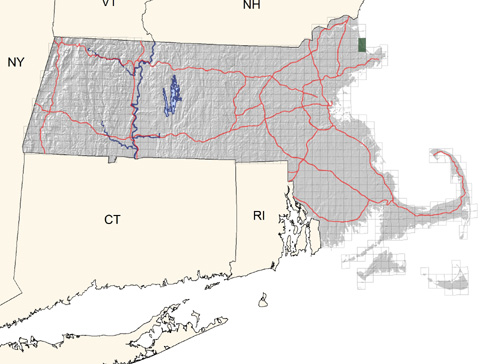Find a Bird - BBA1
Breeding Bird Atlas 1 Species Accounts
Ruddy Duck
Oxyura jamaicensis
Egg Dates
late May to late July
Number of Broods
one; may re-lay if first attempt fails.

This exclusively North American species has an extensive breeding range but is a very uncommon nester in the eastern United States. There are breeding records for Washington County, Maine; Jamaica Bay Refuge and Montezuma National Wildlife Refuge, New York; and Brigantine National Wildlife Refuge, New Jersey. In Massachusetts, there is an old nesting record from Truro. During the Atlas period, Ruddy Ducks bred on the Parker River National Wildlife Refuge, and afterward the species also nested at Monomoy National Wildlife Refuge.
The primary breeding site at the Parker River refuge has been the Stage Island Pool, where a population of Ruddy Ducks has developed since the pool’s construction in the 1950s. Generally, a few pairs and a brood or two can be observed there most summers. However, high-water-level management is probably critical to continued successful nesting by Ruddy Ducks. In 1978, possibly in response to declining deep-water emergent plant habitat at Stage Island, breeding activity was also noted for the first time in the refuge’s North Pool. Habitat in the North Pool, however, has generally been of lower quality due to lower water levels and less flooding of emergent plants.
Ruddy Ducks are uncommon spring migrants and are generally seen in April, although local breeders may return in March. In summer, the adult male is striking and gaudily colored with a reddish chestnut breast and back and a blue bill. This coloration, coupled with the unusual inflatable air sack in the neck and the curious courtship antics, make the drake somewhat reminiscent of a pouter pigeon or a turkey gobbler. As he raises his peculiar quill-like tail over his back, puffs up, and pumps his bill up and down against his breast, he produces one of several courtship vocalizations, sounding as though he is choking. The drab females are generally silent.
The bulky, basketlike nests will float and are most often constructed about 8 inches above water level in emergent vegetation such as cattails. In the western United States sometimes an old coot nest is used. The six to ten (average eight) rough, granular, thick-shelled, white eggs are substantially larger than a Mallard’s. Although the ruddy is one of our smaller ducks, the clutch often weighs two to three times as much as the 1-pound hen, and the females are sometimes parasitic on the nests of other ducks, or even grebes. Hens are very secretive around their nests, usually sliding down a small ramp and swimming away under water without ever being seen. Following a 23- to 26-day incubation period by the female, the extremely large and precocious young hatch and begin diving for food almost immediately, using their big feet most effectively. Unlike the situation with most other duck species, the drake often stays with the family, but the young, which seem to be born “old,” are often on their own by the time they are half-grown.
In 1974, a female and five young were seen on July 20, and, in 1975, an adult with four young was observed at Parker River National Wildlife Refuge from July 1 to 26 (BOEM). Young Ruddy Ducks have been recorded in the Stage Island Pool as late as early to mid-August. Estimated production at the Parker River refuge during the Atlas period was ten to twenty young per year. On Monomoy, an adult with two young was recorded on July 5 (Humphrey). The young reach flight stage from 52 to 66 days of age.
The food of the Ruddy Duck is largely vegetable matter and the seeds, stems, roots, and bulbs of submerged aquatic plants. Because ruddys are reputedly good eating, they have been historically much sought after by hunters during the fall and early winter. They can sink slowly out of sight like grebes, and they swim underwater like a Muskrat, using both feet simultaneously. Like most diving ducks, ruddys have to run across the water to become airborne. They are almost completely helpless on land due to the rear placement of their legs. Ruddy Ducks tend to fly low, even during migration, when they are most often seen traveling near dusk in medium to fairly large groups.
Unlike almost all other ducks, ruddys do not have an eclipse plumage but instead have two distinct plumages, one for the summer breeding season and one for the winter. Winter males lose the blue bill color and resemble their drab mates and the juveniles.
The Ruddy Duck is fairly common in Massachusetts during the fall migration and is especially common locally on favored coastal ponds and impoundments where peak numbers of 50 to 100 may occur. During mild winters, migrants sometimes linger as late as January, but most move farther south along the Atlantic Coast as the winter progresses.
Map Legend and Data Summary
Atlas 1 data collected from 1975-1979


Note: rare and local at Parker River National Wildlife Refuge; also irregularly at Monomoy National Wildlife Refuge
George W. Gavutis, Jr.



